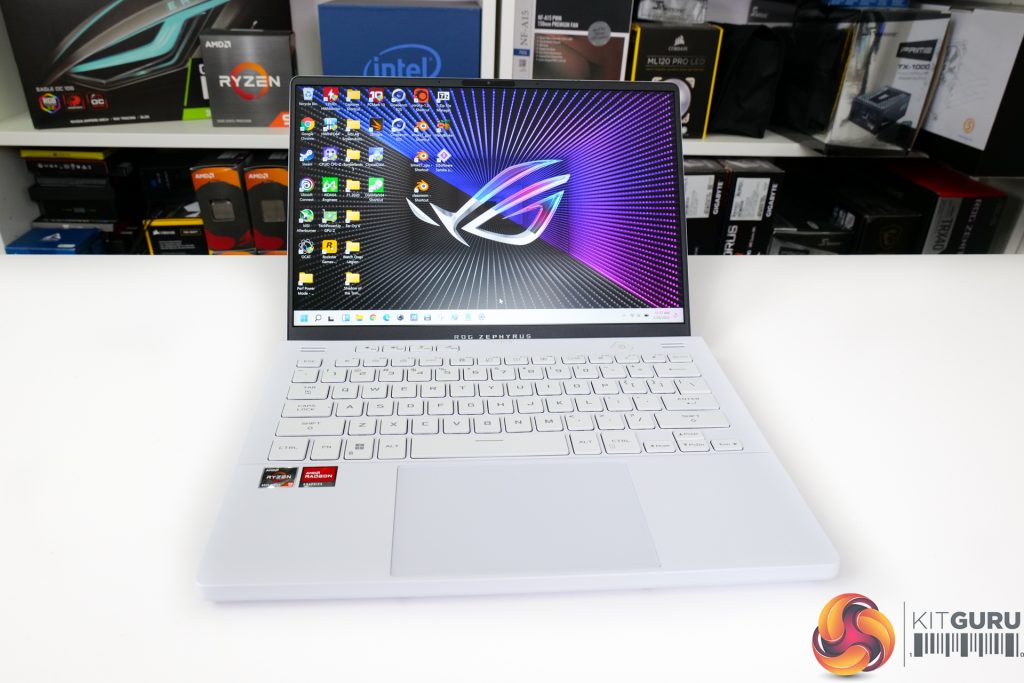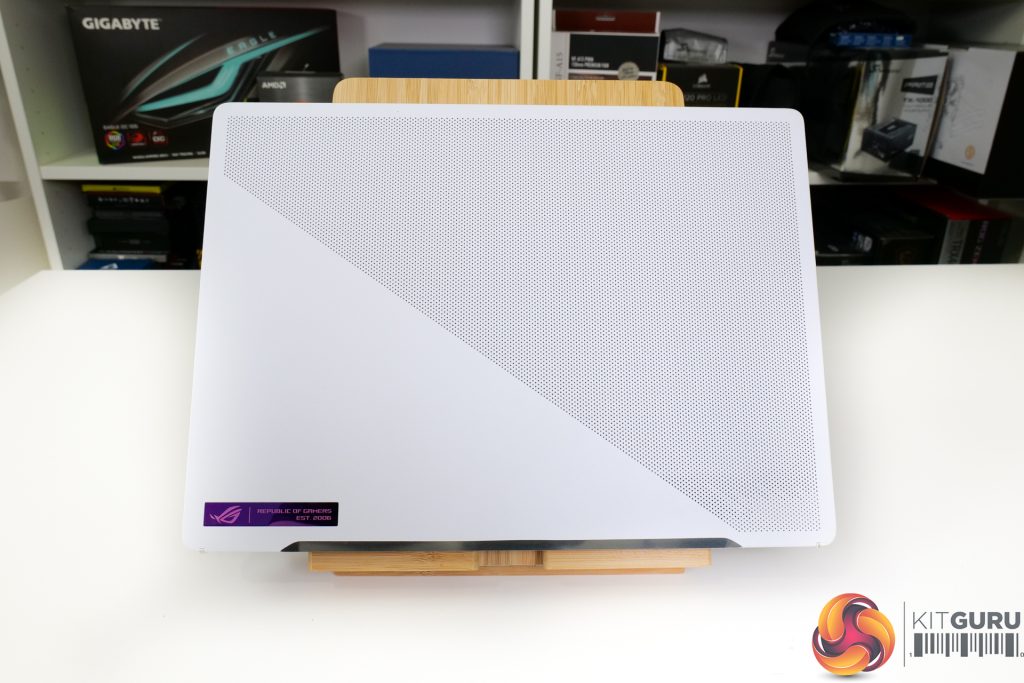We test in the out-of-the-box state with minimal adjustments made to the laptop, other than installing our test software and Windows updates in addition to removing McAfee which is simply infuriating (ASUS, please stop including this!).
That means that each laptop is tested using its ‘Performance’ fan and power profile. We do not use the ‘Turbo' power profile which, in some respects, pushes the hardware (particularly the CPU) beyond the intended power limits from AMD's design perspective. We will examine the behaviour of the ‘Performance' power profile in this review.
We include some comparison data from relevant laptops that we have tested recently and some extras that we have got in for additional testing.
Notably, we have a Core i9-12900H-powered ASUS ROG Flow Z13 laptop. This is a similar, compact form factor to the G14 but features an RTX 3080 Mobile eGPU solution to help us run a proper gaming comparison of the CPUs. The long-duration power of this Core i9-12900H processor is 35W.
We also deploy the ASUS ROG STRIX G17 that we reviewed on the main KitGuru website. This uses a 45W-calibre Ryzen 9 5900HX and a 115W RTX 3070 Laptop GPU. Despite being a much larger 17-inch unit, it will be interesting to see the CPU and GPU performance comparison.
And for some additional test data, we include a 21W-running Ryzen 7 5800U-based ASUS ZenBook 13 and a 28W-rated Core i7-1165G7 Tiger Lake-based Razer Blade Stealth 13.
ASUS ROG Zephyrus G14 GA402RK Laptop Test Configuration:
- Processor: AMD Ryzen 9 6900HS (8C/16T, 3.3GHz Base, up to 4.9GHz Boost 35W Rated TDP Mode)
- Memory: 32GB DDR5 4800MHz
- Graphics Card: AMD Radeon RX 6800S 8GB GDDR6
- Display: 14” 16:10 QHD+ 2560×1600 120Hz IPS-level
- System Drive: 1TB Micron 2450 PCIe Gen4x4 NVMe SSD
- Battery: 76 Whr battery with 240W barrel-style Power Adapter (100W USB-C support)
- Design: 1.75kg weight with around 18.5mm chassis thickness
- Operating System: Windows 11
Comparison Systems:
- ASUS ROG Flow Z13 GZ301ZE (Intel Core i9-12900H System):
- Intel Core i9-12900H (6 P-cores and 8 E-cores, up to 5.0GHz Boost, 45W Rated TDP)
- 16GB LPDDR5 5200MHz
- RTX 3050 Ti Laptop GPU 4GB GDDR6 up to 40W
- ASUS ROG XG Mobile GC31 RTX 3080 Mobile eGPU up to 150W
- 13.4-inch 3840×2400 16:10 60Hz IPS-level
- 1TB M.2 2230 PCIe Gen4x4 NVMe SSD
- 56 Whr battery with 100W USB-C Power Adapter
- 1.18kg weight with 12mm chassis thickness
- ASUS ROG STRIX G17 G713QR (Ryzen 9 5900HX ‘Cezanne' System):
- AMD Ryzen 9 5900HX (8C/16T, up to 4.6GHz Boost, 45W Rated TDP)
- 32GB DDR4 3200MHz SODIMM
- RTX 3070 Laptop GPU 8GB GDDR6 115W
- 17.3-inch FHD (1920 x 1080) 16:9 300Hz IPS-level
- 1TB SK Hynix BC711 PCIe Gen 3×4 NVMe SSD
- 90 Whr battery with 240W barrel-style Power Adapter
- 2.70kg weight with 23.4-28.3mm chassis thickness
- Gigabyte U4 UD-70UK823SO (Core i7-1195G7 ‘Tiger Lake’ System)
- Intel Core i7-1195G7 (4C8T, 28W Rated TDP-up Mode)
- 16GB DDR4 3200MHz (8GB onboard, 8GB SODIMM)
- Integrated Intel Iris Xe iGPU (96 EUs)
- 14″ IPS Full HD 1920×1080 60Hz
- 512GB ESR512GTLG-E6GBTNB4 PCIe Gen4x4 NVMe SSD
- 36 Whr battery with 65W barrel-style Power Adapter
- Slightly below 990g weight with 16.5mm chassis thickness
- Razer Blade Stealth 13 OLED (Core i7-1165G7 ‘Tiger Lake’ System)
- Intel Core i7-1165G7 (4C8T, 28W Rated TDP)
- 16GB LPDDR4 4266MHz
- Nvidia GTX 1650 Ti Max-Q
- 13.3″ OLED Full HD Touch 60Hz
- 512GB Samsung NVMe SSD
- 53.1 Whr battery with 100W USB-C Power Adapter
- 1.41kg weight with 15.3mm thickness
- ASUS ZenBook Flip S OLED UX371 (Core i7-1165G7 ‘Tiger Lake-U’ System):
- Intel Core i7-1165G7 (4C/8T, 1.2GHz Base, 12W Rated TDP-down Mode)
- 16GB LPDDR4X 4266MHz
- Integrated Intel Iris Xe iGPU (96 EUs up to 1.3GHz)
- 13.3” 16:9 UHD 3840×2160 60Hz OLED Touch Display
- 1TB WD SN730 NVMe SSD
- 67 Whr battery with 65W USB-C Power Adapter
- 1.2kg weight with 11.9-13.9mm chassis thickness
- ASUS ZenBook 13 UM325S (Ryzen 7 5800U ‘Cezanne' System):
- AMD Ryzen 7 5800U (8C/16T, 1.9GHz Base, up to 4.4GHz Boost, 15W Rated TDP)
- 16GB LPDDR4X 3733MHz
- Integrated Radeon Vega 8 APU (up to 2GHz)
- 13.3” 16:9 FHD 1920×1080 60Hz OLED Display
- 1TB SK Hynix (HFM001TD3JX013N) NVMe SSD
- 67 Whr battery with 65W USB-C Power Adapter
- 1.12kg weight with 13.9mm chassis thickness
Tests
- Cinebench R23 – All-core & single-core CPU benchmark (CPU Compute), Stress test (Temperatures & Power Consumption)
- Blender 3.0.1 – All-core rendering of the Classroom and BMW scenes (CPU/GPU Compute), Stress test (Temperatures & Power Consumption)
- HandBrake 1.5.1 H264 – Convert 1440p60 H264 video to 1080p60 H264 using the YouTube HQ 1080p60 preset (CPU)
- HandBrake 1.5.1 H265 – Convert 4K30 100Mbps H264 video to 1080p30 40Mbps H265 using the H.265 MKV 1080p30 preset (CPU & Memory)
- 7-Zip 21.07 – Built-in 7-Zip benchmark test (CPU & Memory)
- SiSoft Sandra – Memory bandwidth and Cache & Memory Latency Test (Memory)
- AIDA64 – Memory bandwidth & memory latency (Memory)
- PCMark 10 – Modern Office & Battery Life Test (System Performance & Battery Life)
- 3DMark – Time Spy (1440p) test, Fire Strike (1080p) test, CPU Profile test (Gaming)
 KitGuru KitGuru.net – Tech News | Hardware News | Hardware Reviews | IOS | Mobile | Gaming | Graphics Cards
KitGuru KitGuru.net – Tech News | Hardware News | Hardware Reviews | IOS | Mobile | Gaming | Graphics Cards




